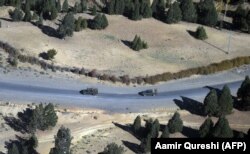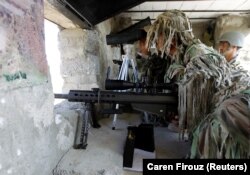Pakistan plans to build a pair of fences -- nine-foot-high, chain-link fences topped with barbed wire – along much of its 2,500-kilometer border with Afghanistan in the hope it will keep out Islamist militants from the neighboring country.
Afghanistan, however, opposes Islamabad’s plans for the disputed frontier. Kabul says the fence would divide families along the Pashtun tribal belt that straddles the colonial-era Durand Line, which the British drew up in 1893.
The project would cost about 56 billion rupees ($532 million), according to estimates by the Pakistani military. There are also plans to build as many as 750 border stations and install high-tech surveillance systems.
In the rolling hills of Angoor Adda village in South Waziristan, part of Pakistan's restive Federally Administered Tribal Areas (FATA), three rolls of barbed wire are sandwiched in the six-foot gap between the chain-link fences.
"(The fence) is a paradigm change. It is an epoch shift in border control management," said a Pakistani Army officer in command of South Waziristan during a presentation to foreign media on October 18.
"There will not be an inch of international border (in South Waziristan) that shall not remain under our observation."
So far, Pakistan’s military has built fences along about 43 kilometers of the border, mainly in the most violence-prone areas of FATA, but the timeline for the whole project is unclear.
Additionally, tens of thousands of troops will need to be recruited to man the border stations.
Gulab Mangal, governor of the eastern Afghan province of Nangarhar, said the wall would create "more hatred and resentment" between the two countries and will do neither any good.
"The fence will definitely create a lot of trouble for the people along the border on both sides, but no wall or fence can separate these tribes," he said. "I urge the tribes to stand against this action."
Pakistan blames Pakistani Taliban militants who it says are based in Afghanistan for a series of attacks in the past year, and Islamabad has urged Kabul to get rid of “sanctuaries” for militants.
In turn, Kabul accuses Islamabad of sheltering the leaders of the Afghan Taliban who are fighting its Western-backed government.
Both countries maintain they do not provide aid to militants, but their relations have worsened in recent years. In May, the tension rose when 10 people were killed in two border villages in the Balochistan region.
The incidents took place in so-called divided villages, where communities are split along the Durand Line and residents now brace for a physical barrier.
Previous attempts by Pakistan to build a fence about a decade ago failed, and many are skeptical that such a lengthy border could indeed be secured.
Pakistani Army officials, however, insist they will complete the fence.
"By the time we are done, inshallah, we will be very sure of one thing: Nobody can cross this place," said the Pakistani officer in charge of South Waziristan.
With reporting by Reuters








